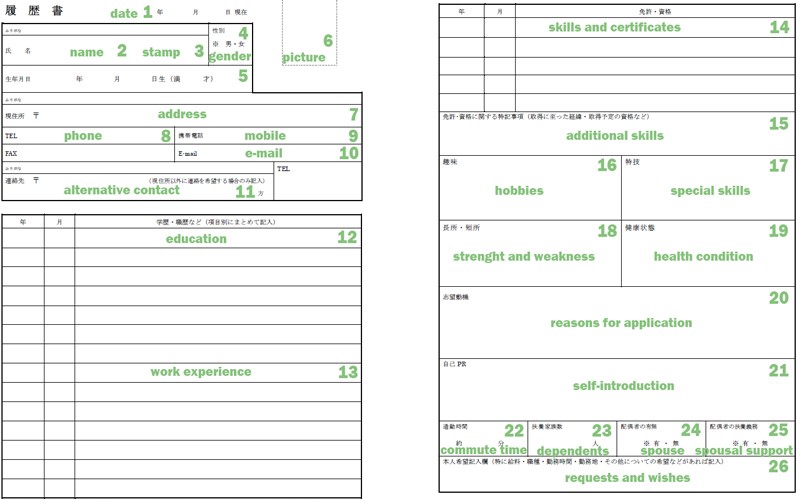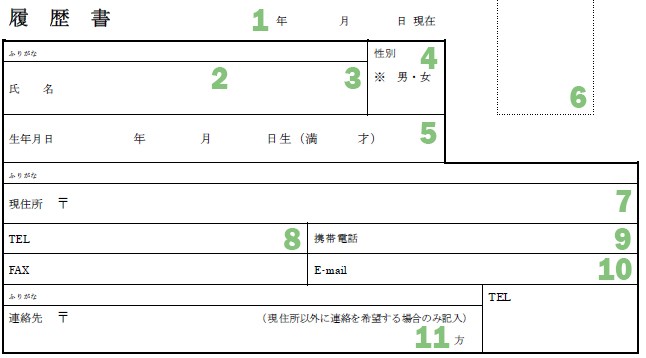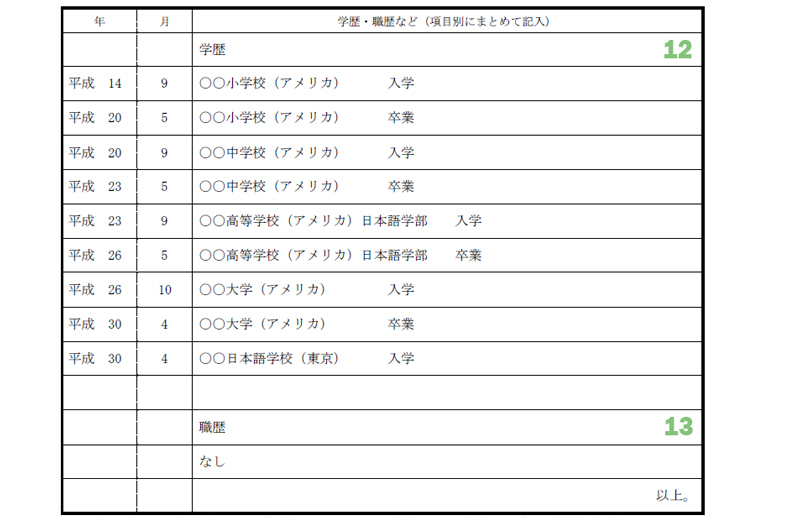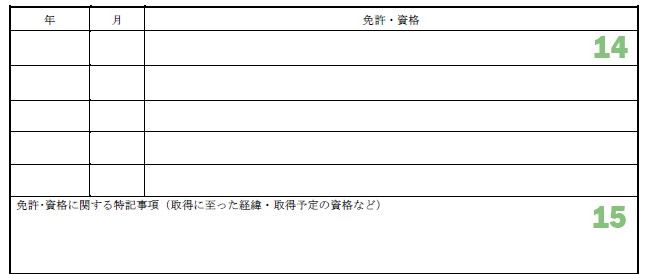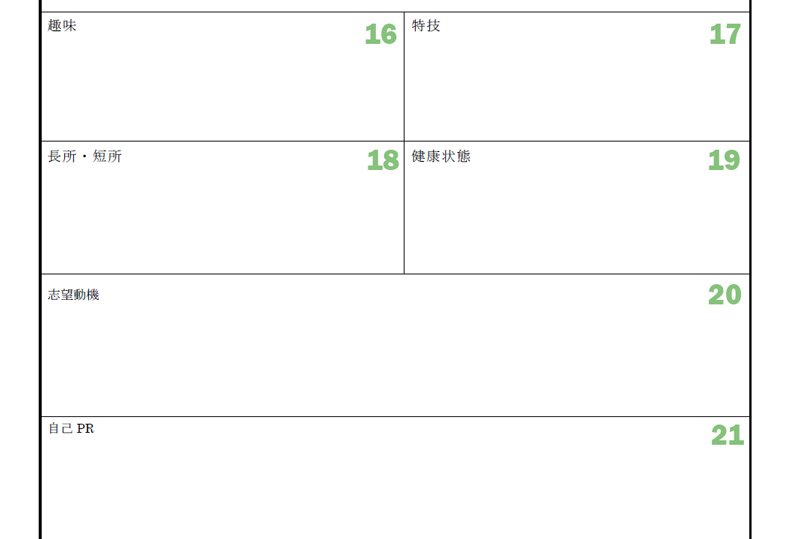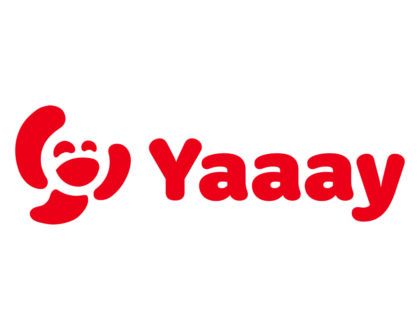How to Write Your Japanese Resume (Rirekisho)

by Madelaine
Writing your first Japanese resume/CV (rirekisho, 履歴書) can be a challenge. But everyone who is hoping to find work in Japan eventually has to write one. Resumes in Japan follow their own logic, and kanji and keigo can complicate the situation, but luckily, they are incredibly uniform.
Just follow this format and remember to adapt your standard answers to really match the position and respective company.
コンテンツ
Japanese resume template
There is no need to design your own resume, you can use a template to simply fill in.
All Japanese resumes are structured into three main parts: 1) basic information 2) education and skills, and 3) motivation and personality. The whole thing is like a CV and a cover letter mixed together.
The resume template below shows what needs to be filled in where.
There are a few different resume templates in Japan. You might be using the standard resume or a company-specific version. But even if the layout is different, the contents should be almost identical. If you manage to write a Japanese CV once, all others after it will take only a fraction of the time.
You can download the standard template (Japan Industrial Standards version) for free in Word, Excel and PDF format over here (the first option on the list).
Before you get started
If furigana is written with hiragana as ふりがな in the resume form, then use hiragana, if it is written as フリガナ use katakana. Always adjust to the format.
It is standard to write dates according to the Japanese calendar as 平成3年5月29日. Use the same date format throughout the resume.
Some companies require a handwritten resume. If that happens to you, make sure you write without mistakes and in even, clean handwriting (uneven handwriting is seen as lacking attention which can lead to failing the selection).
Japanese resumes are typically written in chronological order, starting from days past and ending with your most recent activity.
Japanese resumes are generally written in keigo. So definitely use the ます-form at the end of every sentence. Use advanced keigo when possible, but rather than making a mistake, stick to more simple polite Japanese expressions.
Basic Information
1. Date
Fill in the day of submission or the day before.
Always write the same day as the interview, if you submit in person.
2. Name
You can write your name in the order you are used to, you don’t have to adjust to the Japanese system. (They will call you by the name you write first).
Leave some space between first and last names.
3. Name Stamp
When using your 印鑑 take care to stamp neatly within the box, facing in upright.
Double check that the stamp is visible completely. If you do not have a name stamp, you can either put a sign here or leave the field blank (if you’re unsure, choose the latter).
4. Gender
Most standard rirekisho templates still contain a gender box. If this does not agree with you, leave it blank. Since December 2020, you can also buy resume templates without a gender box (according to the maker’s website, they cost 120 yen).
5. Age
Write your birthday according to the Japanese calendar. In the brackets write your age on the day of submission that you wrote under #1.
6. Photo
Not a thing anymore in many countries, but still standard in Japan: the picture. More precisely, imagine your passport picture and add a suit.
- ✔ 2.4-3cm width, 3.6-4cm height
- ✔ taken within the last 3 months
- ✔ in color, facing the camera, clear headshot, nothing else in the picture
- ✔ business attire
- ✔ smile softly and open your eyes
You can take this one yourself in a photo booth, but remember to check your clothes, makeup and facial expression. If you want to invest for a better picture, you can book special resume photo shoots in Japan, which even come with optional hair and makeup.
READ ON Guide to taking resume pictures in Japan
Add your picture to the CV after you filled everything without spelling mistakes.
To avoid any chance of confusion, write your name on the back of the picture.
7. Current Address
When adding your current address, write the postal code in the first line. Go from big to small, starting with the prefecture, district and working your way down to the room number.
〒 107-0052 東京都 渋谷区 道玄坂 2丁目1 日の出シェアハウス渋谷 #3
After the address remember to put your apartment complex’s name and room number.
Remember to fill in the furigana.
In you live overseas, fill it in in romaji and write it once more in Japanese script in the furigana section.
8. Phone Number
If you have a landline go ahead and fill this out, otherwise leave it blank.
9. Mobile Number
Enter your current phone number.
If you don’t have a phone, consider getting one. It is likely, that HR wants to call you directly to make appointments.
10. E-mail
Use an email address you check frequently and can access from any PC.
Use a “proper” email address, not the one of your cosplay persona or the goofy one you made when you were 14.
11. Alternative Contact
Here you can put an alternative address, in case you are moving, currently still living abroad, or are out of town for an extended period of time.
Just make sure the company knows where to reach you, and that you can receive any documents they may send.
Education and Work History
12. Education
If you’re applying to your first job: Start with the date you entered elementary school! (Do you still remember?)
Do not abbreviate anything. For example, many Japanese people say 高校 when referring to high schools but the full, proper term is 高等学校.
Further Secondary and Tertiary education should be written in chronological order. Don’t forget to include each twice. One line for the date you entered, and one for your graduation. If you got multiple degrees or moved schools as a kid, you might run out of space here. In that case skip your Primary Education, for the sake of your more recent education.
For university and college programs write in the following order:
University name, (country if it’s abroad), faculty, department, subject. You can add your research topic or graduation thesis title if you want.
Language school or studied abroad stays do not need to be written here. You can add them when these studies lasted for more than 6 months and helped you acquire a skill that is relevant to the position you are applying to. Everything else will be considered a vacation.
Also indicate it if you are enrolled in a language school or study abroad program at the time of application.
When changing jobs, it is enough to start the school history from your high school graduation. Otherwise follow the advice above.
13. Work Experience
Same as for your schools, you write everything chronologically and enter both, the date you entered and the date you left the company.
Write the official company name without abbreviations and 入社 next to the date on which you entered the company.
Make sure you got the company name right. Check if 株式会社 comes before or after the name.
If your previous company merged or otherwise changed their names write both the original name and the new one (現〇〇株式会社).
In the second line, indicate the type of company and the number of employees.
Use a third line for your tasks there.
If something in your work history is directly related to the hiring requirements, you can use a 4th line to emphasize those.
If you changed department within a company, add that with a date in an extra line.
Next to the date you left your previous company, write the reason why in the same line. You can use the standard phrase 一身上の都合により退社, meaning you left due to personal reasons.
If you are still working there, write 現在に至る.
If you are still working but the day you leave your current company is decided, then enter it as:
平成〇〇年〇月 株式会社〇〇 退職予定
When you are done, leave some space and write 以上 right corner of a line.
If you find yourself running out of space put 職務経歴書記入 toward the bottom of the area, to say that you will attach the missing information.
READ ON Guide to the Japanese “work experience resume”
When you are done check again: are all your dates in Japanese calendar and correct?
14. Skills and Certificates
Write from the specific to the less specific: start with your licenses or permits, then onto qualifications.
Start with your driver’s license (not very common in Tokyo) if you have one.
Be sure to write all your qualifications with their official names. For example, if you mention your Japanese skills, write 日本語能力試験 and not JLPT. If you are currently studying towards a certain certificate you can also mention it here.
Make sure that everything you write here is relevant to your job. If you know Latin, for example, that’s great, just don’t write down things you have no opportunity to utilize at work.
15. Special mention
Maybe you know how to drive a car but didn’t get your Japanese license yet. Or you are studying toward the JLPT and are positive that you can pass. Here is the space to mention those skills you cannot provide any valid certificate for at the moment.
The cover letter part
The below points may not all be in your specific format, but since some of them definitely show up, I will briefly cover them here.
16. Hobbies
A short list of your hobbies without explanations is enough, whatever you do, do not leave this one blank for the sake of bringing conversation starters. Don’t write too many things so it doesn’t seem like these hobbies are your priority.
If you have hobbies that leave a good impression, even better.
Do you run your own blog? Do you know Ikebana? Do you play soccer (maybe it taught you team play or leadership skills)? Write it down. If you like bungee-jumping or gambling, that might be something to skip, as it may not reflect well on your character.
17. Special Skill
Here you can show what you’re good at and bring in things you couldn’t mention in the certificates section. So you can put your Japanese or IT skills, for which you don’t have any license. Or maybe you learned something relevant to your job during your part-time work or internship.
18. Strength and Weakness
Another popular question is about your strength and weakness. When asked for both, mention one of each. Pick a strength that is relevant to the company and position you are applying to. For your weakness, write down something that doesn’t affect your work (if you are applying as an accountant, not being the most creative person on the planet will hardly be an issue).
19. Health Condition
Another odd, Japanese question. If you are healthy and don’t have any diseases write 良好 (they are not asking for your cold). If you are really going for the robust and healthy appeal, you can also add for how long you haven’t been sick.
きわめて良好(前職では0年間無欠勤ですor0年間病気をしていません.)
If you have some sort of health concern, ask yourself if it impedes your work or not. When the answer is no, do not write it down. (So you can leave out your last cold, short-term sickness, diseases that have healed, chronic diseases that you can deal with without impacting work, or occasionally occurring things like anemia, etc.)
What you have to write down are health issues that require you to see a doctor during work hours or limit what you can do at work (your rehabilitation after some broken bones does fit in here, as does having a problem lifting heavy things.) In this case, write a short explanation sentence.
20. Motivation for Application
What made you apply for this job and why do you want to work at this company? Depending on how much space your template leaves you, you don’t have to write an essay here, but your answer should be longer than one word or sentence (if your template allows for it). Keep the short text structured and easy to follow, and avoid pitfalls like writing about why you want to live in Japan.
READ ONHow to write your motivation for application in Japanese
21. “Self-PR”
Here is your chance to describe what makes you the right candidate and how you can benefit the company. Length should be about the same as the motivation for application Talk about your strengths or things that you have done in the past.
Don’t beat around the bush – give concrete examples and provide “proof” to make the reader really understand your strong points. Also, don’t forget to mention how you want to use your abilities during everyday work.
READ ONHow to write a convincing Self-PR paragraph
22. Commute Time
How long does it take from your house to the company? Leave this one blank if you don’t live in Japan.
90min one way is considered within the normal range for commuting time. If you live more than 90min away from the company and are willing to move for the job, write 内定後速やかに転居可能.
23. Dependents (without spouse)
If you do not have children or other dependents, write 0.
24. Spouse
Circle 有 (yes) if you are married, otherwise choose 無(no).
25. Spousal Support
Are you paying for the living expenses of your spouse? If you don’t have housewife or stay-at-home husband, probably you can choose 無 (no).
26. Requests and Wishes
Here is the place where you can put your expectations or wishes regarding your salary, position, work hours and location.
Things you could write here are for instance the department you want to work at (勤務部署) or the city you want to work in (勤務地).
Pre-submission Checklist
Congratulations on your completed rirekisho!
Before you hand your resume in, double check for any mistakes.
- ✔ contents revised to match position and company
- ✔ no spelling errors
- ✔ all furigana are written correctly
- ✔ every section filled in
- ✔ the picture is attached properly and straight
- ✔ no abbreviations
- ✔ all dates in the same format
- ✔ paper without any folds or stains (if you mail it, use a large enough envelope)
Good luck with your job hunt!
Need advice? Ask job-hunt experts
Today, getting a job in Japan as a foreigner is easier than ever. But if you don’t know all the ins and outs, getting the exact job you want can still be difficult.
Linguage Japanese Language school in Shinjuku specializes in a special blend of Japanese education and job hunt preparation. Their courses (both long- and short-term) teach practical Japanese that you can instantly apply in business settings. Aside from the classes themselves, you can ask teachers to look at and check your resumes and get direct advice on how to get jobs in specific industries. For more info, check our detailed article over here or directly visit the school’s homepage by clicking the button below.
Linguage Japanese Language School

